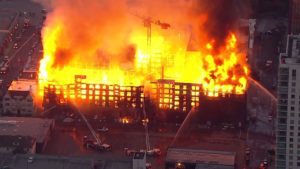IBC – Water Supply for Buildings Under Construction

During construction, buildings are extremely vulnerable. This construction or renovation period requires extra precautions along with specific risk management planning. Many fire protection systems, both passive and active, are just beginning to be installed or shut down and cannot provide required protection. This unprotected period has led to some major catastrophic fires in exposed buildings. While unoccupied, they present a significant hazard to workers, fire service personnel and property that must be mitigated through adoption of specific code requirements. We have seen many of these devastating fires across the United States and have already started to see new requirements heading into the New Year. The newly published 2021 codes have begun to incorporate new requirements, including the requirements for minimum fire flow for buildings under construction.
It was not long ago that the International Building Code (IBC) only required buildings under construction to have an approved water supply for fire protection. The water supply was to be provided as soon as combustible material arrived on a building site. Now, with the adoption of the 2021 edition of the IBC, we have a newly expanded section to provide specific guidance for water supply in buildings under construction.
For many years, Chapter 33 of the IBC (Safeguards During Construction)- Section 3313, had only a single sentence for water supply. This was an extract from the International Fire Code (IFC) (F) 3313.1, stating that the approved water supply for fire protection shall be made available as soon as combustible material arrived on a job site. The IBC has since adopted that requirement into the body of the IBC and expanded it with eight new sections. The expanded sections include fire hydrant configuration regarding combustible material and specific fire flows based on several building characteristics, such as, vertical construction, separation, and type of construction.
While the original requirement extracted from the IFC was retained, it was also expanded to include the additional requirements now found in the building code, including an exception in the IFC that allows fire code officials to reduce the fire flow requirements for isolated buildings in rural or small communities where full fire flow is impractical.
Section 3313.2 requires combustible materials to be located within 500 feet of a fire hydrant with a minimum flow rate of 500 gallons per minute. This 500-foot measurement must be within an approved fire apparatus access lane.
The second addition is a requirement for vertical construction of type III, IV and V construction. This section 3313.3 for combustible vertical construction requires the fire flows found in Section 3313.3.1 – 3313.3.3 to be provided along with fire hydrants sufficient to deliver the proper coverage and fire flow.
The larger addition to the code is found in those sections 3313.3.1 through 3313.3.3. This is where the requirements for fire separation in all type III, IV or V construction for required fire flow can be found.
- Section 3313.3.1 fire separation up to 30 feet. Where the construction is less than 30 feet from property lot lines, existing properties, a minimum of 500 gallons per minute or the entire required building fire flow shall be provided, whichever is greater.
- Section 3313.3.2 fire separation of 30 feet up to 60 feet. Where the construction is 30 feet to 60 feet from property lot lines, existing properties, a minimum of 500 gallons per minute or 50% of the entire required building fire flow shall be provided, whichever is greater.
- Section 3313.3.3 fire separation of 60 feet or greater. Where the construction is 60 feet or greater from property lot lines, existing properties, a minimum of 500 gallons per minute shall be provided.
- Section 3313.4 clarifies the need to comply with the sections for fire flows for combustible materials on a type I or II job site but makes no additional requirements for commencing with vertical construction of type I or II construction.
The final addition to this section of the code is for minimum standpipe supply. Section 3313.5 does not have any requirements relating to combustible material and states that standpipes systems shall be able to provide a minimum flow of 500 gallons per minute. The fire department connection (FDC) must also be within 100 feet of the fire hydrant used to supply the standpipe system. While these may seem like small changes in the IBC, it is the first time that specific fire flows have been regulated in new construction and allows for overall better fire protection of buildings under construction.
